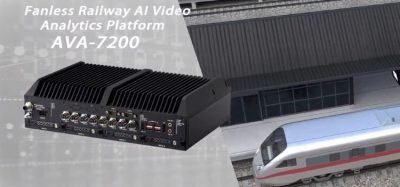Collaborative approach to GSM-R
Posted: 14 February 2006 | | No comments yet
Global Railway Review has previously featured articles which have dealt with the in-depth technical nature of GSM-R1. In this report, Paul Jenkins summarises the progress made by Network Rail, the national owner and operator of the railway in the UK, and outline the next steps being taken to implement the system.
Global Railway Review has previously featured articles which have dealt with the in-depth technical nature of GSM-R1. In this report, Paul Jenkins summarises the progress made by Network Rail, the national owner and operator of the railway in the UK, and outline the next steps being taken to implement the system.
Global Railway Review has previously featured articles which have dealt with the in-depth technical nature of GSM-R1. In this report, Paul Jenkins summarises the progress made by Network Rail, the national owner and operator of the railway in the UK, and outline the next steps being taken to implement the system.
The European picture
As Europe continues to progress towards a closer political union, the European rail industry is making similar progress in the area of railway communications.
The Global System Mobile-Railways (GSM-R) heralds a new age in railway communication, as one standardised digital system, replaces the current plethora of analogue systems used across Europe.
GSM-R implementation in Europe has already begun. Germany, Switzerland, The Netherlands, Italy and Sweden are using GSM-R operationally, and are among several countries across Europe which are developing large-scale GSM-R projects2.
The benefits
The operational and safety benefits of the system have long been understood, and include:
- Direct driver to signaller communication
- Voice communication for other operational railway staff – enhancing the efficiency of communication and thus efficiency of travel
- Emergency prioritised calls – providing certain users the ability to override other calls and pass safety critical information swiftly and accurately
- A standardised platform for future control and signalling systems, such as the European Rail Traffic Management System (ERTMS)
In addition, due to the age and variety of current analogue systems in Britain, creating a modern system which includes developments in GSM technology has become a priority.
Because of the limited access for foreign trains onto its network, the operational benefits of interoperability to the UK are perhaps not as significant as in other European countries. However, standardisation will be of great economic benefit. The use of common equipment across Europe will lead to efficiencies of scale and, consequently, lead time and cost reductions.
Current situation in the UK
GSM-R has been operational on the first section of the Channel Tunnel Rail Link (CTRL), between the Channel Tunnel and Dartford in north Kent, since it opened in 2003.
Though it has achieved 100% coverage of the railway, including tunnels and cuttings, it is used only as a support system for maintenance and not as a train radio solution. The second section of the CTRL, which extends it to new international stations at St Pancras and Stratford (east London), is now being developed by Union Railways and will be ready for operational use in 2007; this section will, again, only initially use GSM-R for maintenance purposes.
The complete GSM-R system on CTRL will be brought into service as a train radio system in conjunction with the introduction of the national GSM-R system across the rest of the south-east of England, currently planned for 2010.
The GSM-R system, delivered on the West Coast Main Line as part of Network Rail’s investment of £8 billion to modernise the route, is being upgraded to enable integration with the national GSM-R system. It will then be brought into operational service in line with the whole of the West Coast Main Line in 2008/9.
Network Rail is now delivering the national GSM-R system in conjunction with the wider overhaul of the Fixed Telecoms Network (the system used for all operational communications). The existing telecoms network is being replaced with new copper and fibre optic cabling and a centrally managed national transmission system, both projects being combined in order to achieve cost and time efficiencies.
For an investment of £1.2 billion, cabling is being laid and GSM-R masts are being erected at more than 2,000 sites across the country between 2004 and 2013. Two national telecoms management centres, the hubs from where the effective operation of the system can be managed and maintained, have already been commissioned.
Once the fixed infrastructure is in place the challenging task of fitting trains with GSM-R equipment, while ensuring a limited impact on operational services, can begin. With almost 10,000 cabs to fit, this process will take some time and will require extensive co-operation between all parts of the UK rail industry.
Network Rail has been working with all rail industry stakeholders, in particular the train operators and their representative body ATOC, since early 2001 to ensure an industry-wide collaborative approach to the introduction of GSM-R. This has culminated in a formal agreement to undertake a trial implementation of the system.
The provision of the train borne GSM-R radio equipment has been contracted to Siemens and the work has completed the initial requirements capture phase and is now into prototype development. In parallel with the development of the radio itself, the issues relating to the fitting of the radios to the trains are now being investigated.
The strategy for user training for the GSM-R systems has been agreed at a national level and Network Rail is working with other industry stakeholders to determine detailed competency and training requirements to establish training programmes in preparation for the system trial and the subsequent national rollout.
The operational trial
Prior to being rolled out as a train radio on a national basis, the GSM-R system will be trialled in the Strathclyde area of Scotland throughout 2007.
Two main sections of track have been chosen for this trial: the 65km stretch between Drumgelloch and Helensborough and the 50km stretch between Glasgow Central Station and Kilmarnock. This area also includes three signalling centres. This area was chosen for the pilot because:
- It provides a manageable area within which to undertake a trial of the system
- The train fleets that operate there are largely restricted to that area
- The existing train radio system is ageing and in need of early replacement
These specific lines of route were chosen as they provide the widest cross section of operational circumstances for trialling the system for the lowest risk to the performance of the area’s operational railway.
Construction of the operational trial network, which includes 24 GSM-R masts was completed in Autumn 2005. Testing carried out by Network Rail’s radio survey vehicle, IRIS II, has shown that the system build meets the design and engineering requirements. A successful operational trial will:
- Prove that the new system meets the UK operating requirements
- Demonstrate the new rules and operating procedures
- Test the processes of fitting trains with the necessary equipment and migrating users onto the GSM-R system
Before the trial can begin several things remain to be completed, which include:
Drivers and signallers
Training development needs to be completed by all drivers and signallers and all training materials provided in order for Network Rail to train its signallers, and local train operators First ScotRail and EWS to train their drivers in the use of GSM-R.
Testing operational work in a desktop environment
Drivers, signallers and other rail staff will work through various scenarios covering normal, abnormal and emergency operation, in order to validate the working of the system in all operational circumstances.
Trains and signal boxes need to be fitted with GSM-R equipment
A total of 60 units run by passenger operator First ScotRail and freight operator EWS, and captive to the area, have been chosen for the trial. Both cabs of each train will be fitted with a handset, radio unit, roof mounted antenna and Man-To-Machine-Interface (MMI). The three Network Rail signalling centres involved in the trial will also be equipped with a total of 12 Fixed Terminal Systems (FTS) for use by signallers. It is expected that these activities will be completed by March 2007.
Because of other train services entering and leaving the trial area, Cab Secure Radio, the analogue system which is currently in place, will not be switched off for the duration of the pilot project. Instead, both systems will continue to be available for use, as appropriate. Cross-industry discussions have concluded that there are no significant safety implications of such dual working.
From July 2007, with the agreement of Her Majesty’s Railway Inspectorate, the trial will be extended to cover the remaining rolling stock and signalling centres in the Strathclyde area, concluding in November 2007.
Final roll-out
It is currently envisaged that the GSM-R infrastructure needed for the system on all primary routes in Britain will be in place by 2009. All secondary routes should be completed by 2011 and full national operation of GSM-R will be achieved by 2013.
The goal of delivering GSM-R is a challenging one, but Network Rail is confident that, working in partnership with the wider railway industry, it can deliver a railway communication system fit for the 21st Century.
References
- Mr. Johann Garstenauer “Rail communications for the 21st Century” Issue 2, 2004
- Mr. Klaus Konrad “GSM-R: where are we today?” Issue 4 2005
Issue
Related topics
European Rail Traffic Management System (ERTMS), Global System for Mobile Communications – Railway (GSM-R)





